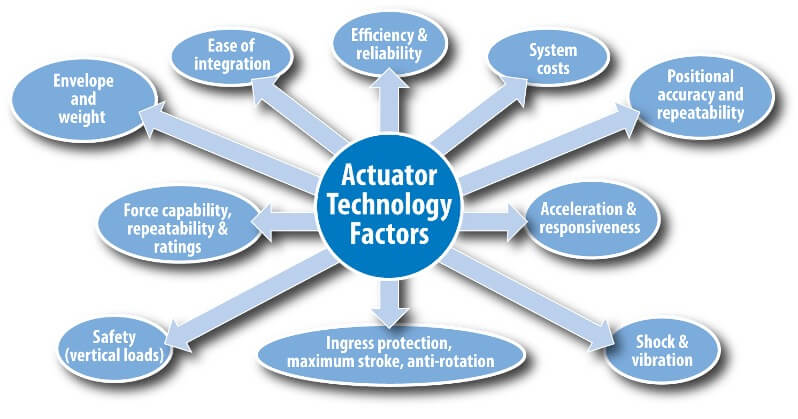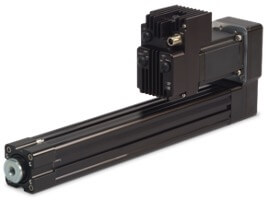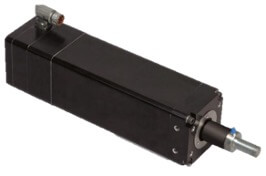Traditional or integrated actuator? 10 factors to consider
By Ryan Klemetson on December 1, 2020
 Take the guesswork out of choosing between two electric actuator technologies
Take the guesswork out of choosing between two electric actuator technologies
Machine design engineers select from a wide range of components when designing linear motion systems. Two common styles of electric rod-style actuators help achieve designs that are reliable and efficient: integrated and non-integrated (aka traditional). Each technology offers performance advantages depending on the application type and requirements. As with any selection process, there are several factors to evaluate.
We list the 10 selection factors below and offer brief comparison tips. For complete details, download our white paper, “Electric actuator technology comparison: Integrated and traditional designs.”
Integrated vs non-integrated: What’s the difference?
 Tolomatic defines traditional actuators as a screw assembly driven by an external motor that is attached to the actuator by a coupler, belt or gearbox.
Tolomatic defines traditional actuators as a screw assembly driven by an external motor that is attached to the actuator by a coupler, belt or gearbox.
Common applications include sawmill/timber processing; food processing; material handling; pressing/riveting; metalworking and tube bending; and oil and gas applications. In these applications, traditional actuators offer ease of integration, ability to provide stroke lengths, high force capability, and internal anti-rotate to name a few.
Examples of Tolomatic traditional actuators include the RSX, RSA and ERD.
 Tolomatic defines integrated actuators as a screw assembly rigidly coupled to and driven by an internal hollow-core servo motor.
Tolomatic defines integrated actuators as a screw assembly rigidly coupled to and driven by an internal hollow-core servo motor.
Applications for this type of actuator can include security barriers, flight simulators and robotic spot welding. In these applications, integrated actuators offer a compact footprint, lighter weight, force repeatability, acceleration and responsiveness, shock and vibration, and ingress protection.
Examples of Tolomatic integrated actuators include the IMA and ServoWeld® (for robotic spot welding).
10 factors to consider
1. System cost. The purchase cost of a traditional actuator is often less than an integrated actuator. Factor in the servo motor, then the traditional actuator cost can become higher. Integrated actuators have competitive pricing and eliminate labor costs associated with mounting and installing the motor, which often makes them the most economical option.
2. Ease of integration. A traditional actuator (mechanical actuator and external servo motor with feedback device) is typically sourced separately from the servo drive and motion controller (different manufacturers). Traditional actuators are typically easier to commission. An integrated actuator combines the mechanical actuator and servo motor into one motion module from the same manufacturer. This single unit must then be integrated with the servo drive and motion controller. Integrated actuators require additional time to configure the integrated actuator to the servo drive and tune the actuator system.
An advantage of integrated actuators is their flexibility to maintain mechanical form, fit and function regardless of the control system being used. This can provide further flexibility for multiple control schemes while avoiding the need to modify mechanical assemblies.
3. Size: Envelope and weight. The integrated actuator’s compact design places the center of gravity along the center axis of the actuator and closer to the mounting face. This facilities more efficient movement when the actuator is used for end-of-arm tooling. Both designs have comparable weight depending on the motor selected and motor-mounting components for the traditional actuator.
4. Platform: ingress protection, maximum stroke, anti-rotation. Integrated actuators have fewer mechanical joints and fasteners for fewer potential ingress points. Traditional actuators allow for longer travel lengths because the nut assembly travels along the screw, providing support along the entire stroke length. The design of the nut assembly in traditional actuators combines support with an internal anti-rotate mechanism. Integrated actuators will typically not be able to accommodate internal anti-rotate provisions while maintaining a high degree of ingress protection.
5. Efficiency and reliability. With fewer moving components than traditional actuators, integrated actuators provide the highest efficiency and reliability.
6. Positional accuracy and repeatability. The integrated actuator’s rigid motor connection provides superior positional accuracy and bi-directional repeatability.
7. Force capability, repeatability and ratings. Traditional actuators provide better performance in high duty cycle and peak performance applications due to more favorable heat dissipation characteristics.
8. Acceleration and responsiveness. The rigid connection in an integrated actuator creates a stiff torque transmission system, resulting in increased acceleration rates and responsiveness.
9. Shock and vibration. Because of a low center of gravity that is closer to the mounting face, integrated actuators will typically have a higher tolerance to shock and vibration loads.
10. Safety considerations for vertical loads. Integrated actuators provide a rigid connection between the brake and screw assembly to ensure safe operation in vertical loads.
Which to choose?
As you can tell from this comparison, the choice between an integrated and traditional actuator is fairly evenly weighted. One of the two most important things to keep in mind when choosing between the two is that getting the correct motor-mount interface for a traditional actuator can be a challenge. Tolomatic helps you solve that issue with our “Your Motor Here” program.
If you are designing for a vertical application, make sure to mitigate risk and ensure proper safety provisions are in place. This could be through the use of an ACME nut and screw or with the use of a spring applied (fail-safe brake).
We can help
If you’re still weighing what’s the best choice for your application you can always ask an engineer for help.
